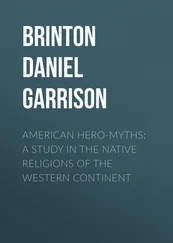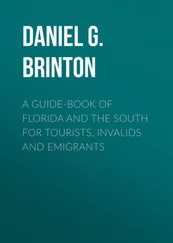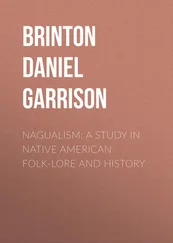Daniel Brinton - The Lenâpé and their Legends
Здесь есть возможность читать онлайн «Daniel Brinton - The Lenâpé and their Legends» — ознакомительный отрывок электронной книги совершенно бесплатно, а после прочтения отрывка купить полную версию. В некоторых случаях можно слушать аудио, скачать через торрент в формате fb2 и присутствует краткое содержание. Жанр: foreign_antique, foreign_prose, на английском языке. Описание произведения, (предисловие) а так же отзывы посетителей доступны на портале библиотеки ЛибКат.
- Название:The Lenâpé and their Legends
- Автор:
- Жанр:
- Год:неизвестен
- ISBN:нет данных
- Рейтинг книги:4 / 5. Голосов: 1
-
Избранное:Добавить в избранное
- Отзывы:
-
Ваша оценка:
- 80
- 1
- 2
- 3
- 4
- 5
The Lenâpé and their Legends: краткое содержание, описание и аннотация
Предлагаем к чтению аннотацию, описание, краткое содержание или предисловие (зависит от того, что написал сам автор книги «The Lenâpé and their Legends»). Если вы не нашли необходимую информацию о книге — напишите в комментариях, мы постараемся отыскать её.
The Lenâpé and their Legends — читать онлайн ознакомительный отрывок
Ниже представлен текст книги, разбитый по страницам. Система сохранения места последней прочитанной страницы, позволяет с удобством читать онлайн бесплатно книгу «The Lenâpé and their Legends», без необходимости каждый раз заново искать на чём Вы остановились. Поставьте закладку, и сможете в любой момент перейти на страницу, на которой закончили чтение.
Интервал:
Закладка:
The population was, however, very sparse, owing to the predatory incursions of the Susquehannocks, whose trails, leading up the Octorara and Conestoga, and down the Christina and Brandywine Creeks, were followed by war parties annually, and desolated the west shores of the Bay and lower river. When, in 1634, Captain Thomas Young explored the river, the few natives he found on the west side told him (through the medium of his Algonkin Virginian interpreter) that the "Minquaos" had killed their people, burnt their villages, and destroyed their crops, so that "the Indians had wholly left that side of the river which was next their enemies, and had retired themselves on the other side farre up into the woods." [58] Footnote_58_58 A Brief Relation of the Voyage of Captayne Thomas Yong , in Mass. Hist. Soc. Colls. , 4th series, Vol. IX, p. 119.
North of the Chikelaki, Smith's map locates the Macovks . This name does not appear in later authors, but near that site were the Okahoki band, who occupied the shores of Ridley and Crum creeks and the land between them. There they remained until 1703, when they were removed to a small reservation of 500 acres in what is now Willistown township, Chester county. [59] Footnote_59_59 See the original Warrant of Survey and Minutes relating thereto, in Dr. George Smith's History of Delaware County, Pa. , pp. 209, 210 (Phila., 1862). The derivation is uncertain. Captain John Smith gives mahcawq for pumpkin, and this appears to be the word in the native name of Chester Creek, Macopanackhan , which is also seen in Marcus Hook. (See Smith's Hist. Del. Co. , pp. 145, 381.) I am inclined to identify the Macocks with the M'okahoka as "the people of the pumpkin place," or where those vegetables were cultivated.
These three sub-tribes had each its totemic animal, from which it claimed a mystical descent. The Minsi had the Wolf, the Unami the Turtle, and the Unalachtigo the Turkey. The Unamis claimed and were conceded the precedence of the others, because their ancestor, the Turtle, was not the common animal, so-called, but the great original tortoise which bears the world on its back, and was the first of living beings, as I shall explain on a later page.
In referring to the totemic animals the common names were not used, but metaphorical expressions. Thus the Wolf was referred to as Ptuksit , Round Foot ( ptuk , round, sit , foot, from the shape of its paws;) the turtle was Pakoango , the Crawler; and the turkey was Pullaeu , he does not chew, [60] Footnote_60_60 The Shawnee word is the same, pellewaa , whence their name for the Ohio River, Pellewaa seepee , Turkey River. (Rev. David Jones, Journal of Two Visits Made to Some Nations of Indians on the West Side of the River Ohio in 1772 and 1773 , p. 20.) From this is derived the shortened form Plaen , seen in Playwickey , or Planwikit , the town of those of the Turkey Tribe, in Berks county, Pa. (Heckewelder, Indian Names , p, 355.)
referring to the bird's manner of swallowing food.
The signs of these animals were employed in their picture writing, painted on their houses or inscribed on rocks, to designate the respective sub-tribes. But only in the case of the Unamis was the whole animal represented. The Turkey tribe painted only one foot of their totemic bird, and the Minsi the extended foot of the wolf, though they sometimes added an outline of the rest of the animal. [61] Footnote_61_61 Heckewelder, Hist. Indian Nations , pp. 253-4.
These three divisions of the Lenape were neither "gentes" nor "phratries," though Mr. Morgan has endeavored to force them into his system by stating that they were "of the nature of phratries." [62] Footnote_62_62 Lewis H. Morgan, Ancient Society , pp. 171-2.
Each was divided into twelve families bearing female names, and hence probably referring to some unexplained matriarchal system. They were, as I have called them, sub-tribes. In their own orations they referred to each other as "playmates." (Heckewelder.)
The native name of New Jersey is given as Shã'akbee (English orthography: ã as in fate); or as the German missionaries wrote it, Sche'jachbi . It is a compound of bi , water, aki , land, and the adjective prefix schey , which means something long and narrow ( scheyek , a string of wampum; schajelinquall , the edge of the eyes, the eyelids, etc.) This would be equivalent to "long-land water," and, according to the rules of Delaware grammar, which place the noun used in the genitive sense before the noun which governs it, the term would be more suitable to some body of water, Delaware bay or the ocean, than to the main land.
The Lenape distinctly claimed the whole of the present area of New Jersey. Their great chief, Tedyuscung, stated at the Conference at Easton (1757), that their lands reached eastward to the shore of the sea. The New Jersey tribes fully recognized their unity. As early as 1694, at an interview with Governor Markham at Philadelphia, when the famous Tamany and other Lenape chieftains were present, Mohocksey, a chief of the Jersey Indians, said: "Though we live on the other side of the water ( i. e. , the Delaware river), yet we reckon ourselves all one, because," he added, giving a characteristically native reason, "because we drink one water." [63] Footnote_63_63 Minutes of the Provincial Council of Pennsylvania , July 6th, 1694.
The names, number and position of the Jersey tribes have not been very clearly made out. A pamphlet published in London, in 1648, states that there were twenty-three Indian kinglets in its area, with about 2000 warriors in all. Of these, Master Robert Evelin, a surveyor, who spent several years in the Province about 1635, names nine on the left bank of the Delaware, between Cape May and the Falls. The names are extremely corrupt, but it may be worth while giving them. [64] Footnote_64_64 Master Evelin's Letter is printed in Smith's History of New Jersey , 2d ed. Some doubt has been cast on his letter, because of its connection with the mythical "New Albion," but his personality and presence on the river have been vindicated. See The American Historical Magazine , Vol. I, 2d series, pp. 75, 76.
1. Kechemeches, 500 men, five miles above Cape May.
2. Manteses, 100 bowmen, twelve leagues above the former.
3. Sikonesses.
4. Asomoches, 100 men.
5. Eriwoneck, 40 men.
6. Ramcock, 100 men.
7. Axion, 200 men.
8. Calcefar, 150 men.
9. Mosilian, 200 men, at the Falls.
Of these, the Mantes lived on Salem creek; Ramcock is Rancocas creek; the Eriwoneck are evidently the Ermomex of Van der Donck's map of 1656; Axion may be for Assiscunk creek, above Burlington, from Del. assiscu , mud; assiscunk , a muddy place. Lindstrom and Van der Donck name the most Southern tribe in New Jersey Naraticons . They were on and near Raccoon creek, which on Lindstrom's map is Narraticon Sipu , the Naraticon river. Probably the English name is simply a translation of the Del. nachenum , raccoon.
In 1675 the number of sachems in Jersey of sufficient importance for the then Governor Andros to treat with were four. It is noted that when he had made them the presents customary on such occasions, "They return thanks and fall a kintacoying, singing kenon, kenon ." [65] Footnote_65_65 New Jersey Archives , Vol. I, p. 183.
This was the Delaware genan ( genama , thank ye him. Zeis).
The total number in New Jersey a few years before this (1671) were estimated by the authorities at "about a thousand persons, besides women and children." [66] Footnote_66_66 Ibid, Vol. I, p. 73.
Интервал:
Закладка:
Похожие книги на «The Lenâpé and their Legends»
Представляем Вашему вниманию похожие книги на «The Lenâpé and their Legends» списком для выбора. Мы отобрали схожую по названию и смыслу литературу в надежде предоставить читателям больше вариантов отыскать новые, интересные, ещё непрочитанные произведения.
Обсуждение, отзывы о книге «The Lenâpé and their Legends» и просто собственные мнения читателей. Оставьте ваши комментарии, напишите, что Вы думаете о произведении, его смысле или главных героях. Укажите что конкретно понравилось, а что нет, и почему Вы так считаете.












